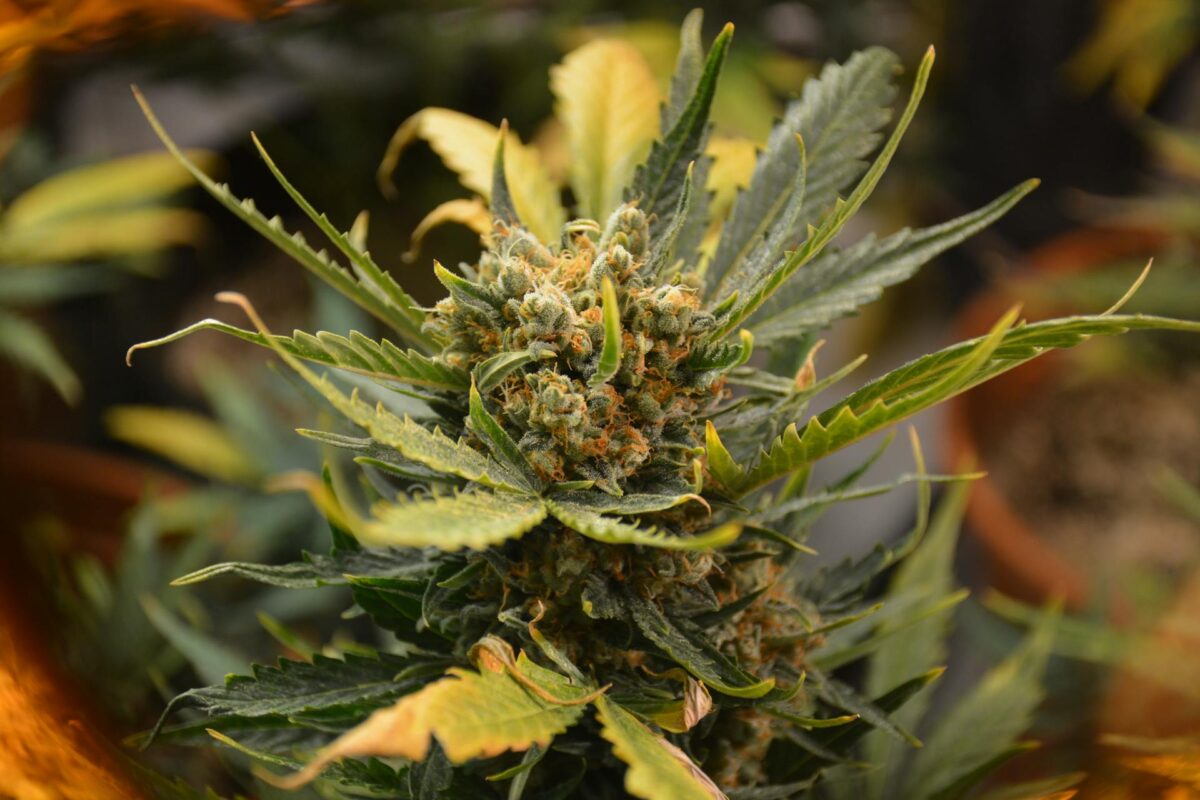The Role of THC, CBD, and Terpenes in a Weed Flower
Cannabis or weed flower stands as one of the most favored cannabis products, often enjoyed through vaping or smoking with bong. This diverse selection presents a range of cannabis strains, each possessing distinct qualities. What makes it intriguing is the presence of multiple components within cannabis flowers that contribute to their effects and benefits.
Cannabis flowers consist of two main components: cannabinoids and terpenes. Together, these elements create the entourage effect, which amplifies the potency and efficacy of the plant’s properties.
Contents
Key Takeaways:
- Cannabis plants comprise cannabinoids and terpenes.
- Cannabinoids and terpenes work together to create the phenomenon called entourage effect.
- Terpenes play a dual role in cannabis flower by contributing both to its distinctive flavor and aroma, as well as to various medicinal benefits.
The Basic Compounds of Cannabis
Farmers primarily grow Cannabis sativa L for its secondary metabolites, particularly cannabinoids, which cannabis research studies have well-documented for their health benefits and increasing pharmaceutical potential. Terpenes, another essential group of metabolites, are also under extensive study.
Cannabinoids
Cannabinoids are chemical compounds in Cannabis plant that contain over 113 identified chemicals. The distinction between marijuana and hemp depends on the THC percentage within the cannabis plant biomass. If a marijuana plant extract contains more than 0.3% THC, it’s a medical marijuana product. When the THC percentage in Cannabis sativa Linnaeus falls below 0.3%, it’s hemp.
Terpenes
Terpenes, a diverse group of organic molecules, play a role in the organic aromas of marijuana flower. The most prevalent compounds are β-caryophyllene, limonene, and linalool in approximately 50 to 70% of all studied cannabis plants. Unlike male plants, the trichomes of female cannabis plant houses terpenes in the form of sticky resin glands. Cannabis plants provide over 150 varieties.
Tetrahydrocannabinol or THC
THC stands as the primary psychoactive compound within marijuana plant and dictates the plant’s euphoric effects.
When THC molecules in cannabis bud traverse the blood-brain barrier, they bind to specific receptors within the endocannabinoid system (ECS) dispersed throughout the brain and body. When activated through binding, these receptors can disrupt neuronal communication, resulting in the well-known “high” sensation, along with feelings of spaciness and intoxication.
Medical Benefits
- Improving Pain Management: A comprehensive systematic review conducted in 2015 assessed various studies involving cannabis and chronic pain patients. The study revealed that cannabis THC usage like pharmaceutical drugs increased the likelihood of experiencing relief by approximately 40%.
- Alleviating Chemotherapy-Induced Nausea: In a notable study of chemotherapy, patients who received a cannabis THC-containing drug alongside medications reported significantly better relief from nausea and vomiting compared to those who underwent standard treatment alone.
- Enhancing Sleep Quality: THC can alleviate short-term sleep issues by mitigating disturbances during sleep and expediting the process of falling asleep.
- Reduces Muscle Spasm: A 2015 systematic review revealed that the combined use of THC and other cannabinoids resulted in reduced self-reported muscle spasms in paraplegics, showcasing the effectiveness of this combined cannabinoid treatment for alleviating muscle spasms.
Cannabidiol or CBD
Cannabinoid research studies suggest that CBD, consumed by an average person, interacts differently with the nervous system, such as the ECS. It attaches to an alternative site on the CB1 receptor, termed an “allosteric” binding site. CBD, unlike THC, does not activate the same signal cascade. Instead, it tends to alter the binding of THC and endocannabinoids to the CB1 receptor, resulting in reduced psychoactive effects while maintaining other distinct benefits.
The influence of CBD in cannabis flower isn’t limited to THC modulation in the nervous system. It also engages with CB2 receptors, which induces calming and sedative effects. It activates adenosine receptors, which play a role in regulating glutamate and dopamine levels in the brain.
Health Benefits
- Anxiety Relief: CBD may alleviate anxiety by reducing stress levels and heart rate, improving symptoms associated with post-traumatic stress disorder (PTSD) or depression, and promoting sleep in cases of insomnia.
- Anti-Seizures: In a 2016 study involving 214 individuals diagnosed with epilepsy, participants supplemented their existing anti-epilepsy medications with daily oral doses of 2 to 5mg of cannabis CBD. Over 12 weeks, there was a noteworthy reduction in seizures, with participants experiencing an average decrease of 36.5 percent per month.
- Pain Relief: In a 2018 study, CBD’s pain-relieving effects were examined in seven patients with chronic pain after kidney transplants. Preliminary findings indicated that six of the seven participants reported a reduction in pain.
The Synergistic Effects of CBD and THC
CBD and THC in cannabis have an intriguing interaction: CBD reduces THC’s cognitive effects, while THC enhances CBD’s physical effects. This synergistic effect goes beyond moderation, as both compounds can enhance each other. THC primarily interacts with CB1 receptors in the brain, while CBD targets CB2 receptors in the body.
CBD and THC in cannabis work together to promote the formation of these structures, enhancing the functionality of the endocannabinoid system more effectively than either compound alone. This interaction also explains how CBD mitigates the psychoactive effects of THC, achieving a biochemical balance.
Terpenes
There are hundreds of terpenes, each hinting at specific sensory characteristics of cannabis leaves, significantly influencing consumer experiences and market valuation. Terpenes contribute substantially to the therapeutic benefits of marijuana flower, particularly in the realm of aromatherapy.
Most Common Types
| Terpenes | Myrcene | Pinene | Caryophyllene | Terpinolene | Limonene |
| Aroma/Flavor | Herbal | Pine | Peppery | Fruity | Citrus |
| Sample Strains | Red Congo | Blue Dream | Gorilla Glue #4 | Jack Herer | Gelato Cake |
| Effects/ Benefits | Anti-inflammatory and Analgesic | Pain Relieving and Anti-inflammatory | Pain Regulation and Mood Improvement | Anti-bacterial and Sedating | Stress Relieving |
Impact of Cannabis Terpenes
Cannabis terpenes exert a multifaceted influence on our experience with cannabis plant. This impact hinges on various factors:
- The types
- Concentrations
- Combinations of terpenes present in the weed flower
- Accompanying cannabinoids and other compounds
- Current status of individual patients
Terpenes in marijuana flower contribute to its aroma and are associated with specific medicinal or psychoactive effects. These compounds interact with receptors in the body and have significant bioactivity. For example, strains rich in linalool promote relaxation and pain relief, while those high in limonene can enhance mood beyond cannabinoids alone.
In a 2018 review, patients using full-spectrum CBD extract, which includes cannabinoids and terpenes, for epilepsy treatment reported improved symptoms and fewer side effects compared to those using CBD isolate containing only cannabinoids.
The Entourage Effect: THC, CBD and Terpenes
The entourage effect suggests that the combined action of cannabis chemicals is more potent when they work together, rather than when any single chemical is isolated.
To illustrate, consider how THC interacts with CBD. When consumed alone, THC can induce its full spectrum of psychoactive effects, potentially leading to side effects such as anxiety and paranoia. Smoked cannabis CBD modulates the psychoactive impact of THC, which results in a milder high with reduced potential for anxiety.
This phenomenon of the entourage effect not only has implications for recreational cannabis smoke but also holds promise for medicinal applications. Further evidence suggests that the terpene profiles of cannabis plants can also induce certain effects that are medically necessary.
Sativex, the first FDA-approved cannabinoid drug for managing Multiple Sclerosis spasms, exemplifies the entourage effect. The combination of THC, CBD, terpenes, and flavonoids in the cannabis plant was found to be more effective at alleviating symptoms than isolating any single cannabinoid.
Choose the Right Cannabis Flower
- Clarify your Desired Outcomes: Identify the desired effects you want, as this will help you search for a widely available strain that matches your goals.
- Look for the Aroma and Flavor: Examine a cannabis plant strain’s terpene profile to ascertain its specific flavor and aroma characteristics. If this information is not readily available, don’t hesitate to inquire with your budtender.
- Check the Price: A high price doesn’t necessarily guarantee the best quality of cannabis flower. Sometimes, more affordable top-shelf grade strains offer strong potency or effectively provide the desired benefits.
- Trial and Error: Explore multiple varieties by purchasing variety packs of ground flower, seeds, edibles, oils, pre-rolls, tinctures, and other cannabis products. You may also obtain small quantities of hybrid strain, sativa strains, or indica to experiment which works best for you.
Conclusion
Understanding the components of cannabis—THC, CBD, and terpenes—provides valuable insight into how a particular cannabis flowering plants function and positively affect the human body. These elements play a role in determining the cannabis strain’s potency, flavor profile, and overall subjective effects. By familiarizing yourself with these cannabis use components, you can make more informed decisions when selecting a cannabis flower that aligns with your preferences.
Frequently Asked Questions
Does cannabis terpenes make you high?
Terpenes do not possess intoxicating properties like THC. Although non-intoxicating themselves, terpenes in marijuana flower can still influence the unique effects of THC and other two cannabinoids in cannabis plant, especially in young people.
The concentration of cannabis CBD, THC, and terpenes in a cannabis flower or female plants varies depending on the specific cannabis strain. THC content, for instance, can range from as low as 10% to as high as 30% in different strains. Similarly, CBD levels in marijuana flower can vary significantly.
What are the dominant terpenes in Cannabis Indica and Sativa flowers?
Cannabis Indica strains exhibited a predominance of β-myrcene, present in high relative concentrations, accompanied by either limonene or α-pinene as the second most abundant terpenoid. Cannabis Sativa L strains exhibit elevated levels of energizing and uplifting terpenes, such as limonene and pinene.


